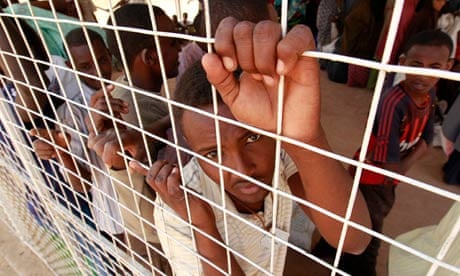The UN refugee agency has begun moving displaced Somalis to a new camp extension at the Dadaab refugee complex in Kenya to relieve overcrowding.
Relief groups are struggling with an influx of mainly Somali refugees fleeing drought and conflict that has left more than 12 million people in need of humanitarian assistance. Some 70,000 refugees have arrived in Kenya in the last two months; 40,000 in July alone, according to UNHCR. The number of refugees at Dadaab has swelled to 440,000.
More than 3,000 Somali refugees have been moved from the outskirts of Dadaab – 60 miles from the Somali border – to what is known as the "Ifo extension".
The site will provide tents for 90,000 people by the end of November.
Latrines and water reservoirs have been constructed and are already in use by the 3,207 people who have moved there since last Monday. Two sites, previously known as Ifo 2 and Ifo 3, have been consolidated to form the new Ifo extension camp.
Ifo 2 was designed to relieve overcrowding last year, before the latest influx, when numbers at the camp hit more than 300,000. Dadaab is the biggest refugee complex in the world and was officially declared full in 2008. The complex is made up of three camps – Dagahaley, Ifo, Hagadera – and now the Ifo extension.
Some 15,000 homes made from mud and brick with corrugated iron roofing were going to be built at Ifo 2 until UNHCR received a letter from the Kenyan government asking work on the site to be stopped. Only 1,116 dwellings were built and, of the three schools to be built, two were finished. There is a health clinic and four water wells. As more refugees arrived in Kenya, some have been setting up tents by the Ifo 2 site, in what became known as Ifo 3.
Even with the new Ifo extension site, aid officials fear that it will not be enough to cope with the numbers pouring across the border.
"Opening Ifo 2 and the extension site is only one step towards getting assistance and protection up to international standards and towards durable solutions for refugees," said Andrew Wander, a spokesman for the NGO Save the Children, who has just returned to the UK from Dadaab.
Save the Children says the number of refugees is so high there is a backlog of 16,000 people who have to live in the bush outside the refugee camps. This mean families, many with young children, having to live in makeshift shelters without proper sanitation and far from clinics, schools and other services.
The group says a backlog in the registration process, under the control of the Kenyan government, means new arrivals cannot settle in the main camp.
"Any children fleeing hunger and war in Somalia are arriving at the camp exhausted and clinging to life. We need to do better than pushing them out to live in the bush. When they are outside the main camp they struggle to find clinics, feeding centres and schools," said Prasant Naik, head of Save the Children in Kenya.
The NGO is urging the Kenyan authorities to speed up registration by putting more resources into the camp and increasing the number of officials.
Refugees who arrive are given basic rations to last them for 21 days, until they register and become eligible for regular food distributions. However, many thousands have to wait longer than three weeks because of the backlog, so they subsist on the basics and rely on family and friends to help tide them over until the paperwork is complete.
In a worrying development, the International Rescue Committee is reporting an increase in rapes and attempted rapes in the complex. It says there was a four-fold increase in the number of cases of sexual violence compared with figures from January to May 2011, although the group did not provide absolute figures.
"More and more women are coming forward who have been raped," Sinead Murray, an aid worker with IRC told the Associated Press, adding that most rapes go unreported.
Work has started in another site, near the Hagadera camp, known as Kambioos, where the land is being cleared. Plots are being demarcated and tents will be erected to house 90,000 people. By the end of November, 180,000 people will have been moved to both the Ifo extension and Kambioos sites.
While UNHCR's airlifts have brought thousands of tents to Dadaab, there are not enough.
In Ethiopia, more than 75,000 Somalis have arrived in the Dollo Ado camp since the beginning of the year. The influx continues at the rate of 240 a day in Dollo Ado and 1,300 daily in Dadaab.
More than 800,000 Somalis are now living outside Somalia, while nearly 1.5 million are internally displaced, mostly in the south-central region.





